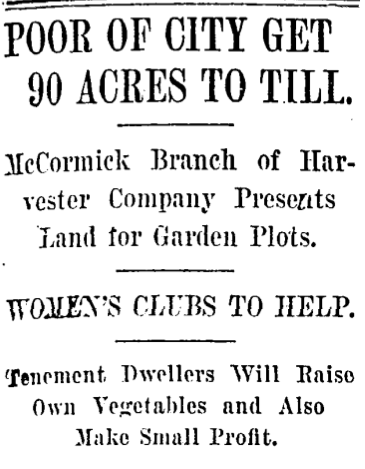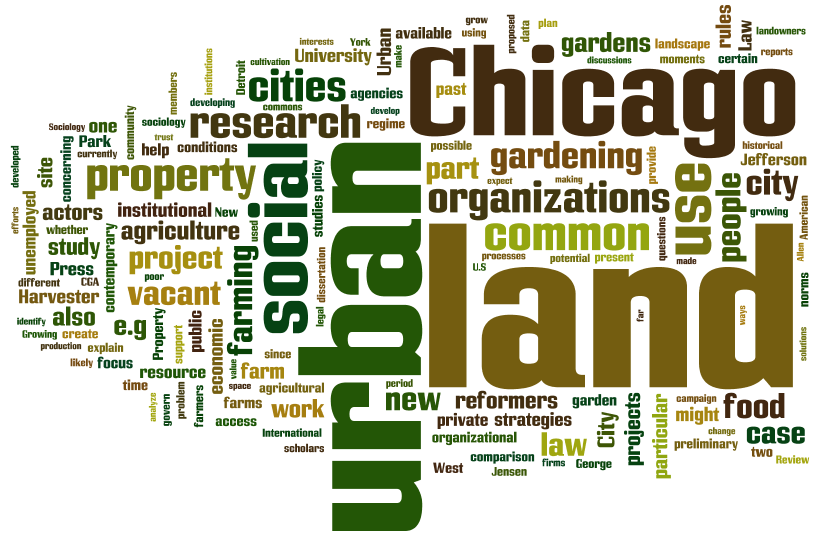Today is Thomas Jefferson’s birthday; he would be turning 271 years old. It feels like a good day to mention how one of Jefferson’s writings on property has influenced my thinking about urban farming. In the fall of 1785, when he was 42, Jefferson was living in France. In late October, he traveled to Fontainbleau, a village outside of Paris where the king had a palace, and went every year to go hunting.

Pierre-Denis Martin, Vue du Château de Fontainbleau (1718-1723). Click for source and higher resolution image.
This was Jefferson’s first visit to Fontainbleau, so he decided to take a walk to the top a nearby hill and get a view of the countryside. In a letter to James Madison, he wrote that
As soon as I had got clear of the town I fell in with a poor woman walking at the same rate with myself and going the same course. Wishing to know the condition of the labouring poor I entered into conversation with her, which I began by enquiries for the path which would lead me into the mountain: and thence proceeded to enquiries into her vocation, condition and circumstance. She told me she was a day labourer, at 8. sous or 4 d. sterling the day; that she had two children to maintain, and to pay a rent of 30 livres for her house (which would consume the hire of 75 days), that often she could get no emploiment, and of course was without bread. As we had walked together near a mile and she had so far served me as a guide, I gave her, on parting 24 sous. She burst into tears of a gratitude which I could perceive was unfeigned, because she was unable to utter a word. She had probably never before received so great an aid.
Jefferson wrote that “This little attendrissement, with the solitude of my walk led me into a train of reflections on that unequal division of property which occasions the numberless instances of wretchedness which I had observed in this country and is to be observed all over Europe.”
The property around Fontainbleau, he observed, was concentrated into the hands of just a few owners. These landowners employed some of the villagers, but these were ultimately fewer than “the most numerous of all the classes, that is, the poor who cannot find work.” Jefferson asked himself, “what could be the reason that so many should be permitted to beg who are willing to work, in a country where there is a very considerable proportion of uncultivated lands?”
Most obvious, of course, was that much of the land was reserved for hunting. But Jefferson reasoned that it was the enormous wealth of the landowners that allowed them to ignore the additional revenue they might generate by allowing people to cultivate their land. An equal division of property, Jefferson observed, was “impracticable.” “But the consequences of this enormous inequality producing so much misery to the bulk of mankind,” he argued, mean that “legislators cannot invent too many devices for subdividing property.”
Jefferson went on to consider some of these devices. All children could be allowed to inherit property, rather than just eldest sons. Or property could be taxed progressively, above a certain threshold.
But then comes the most interesting part. Jefferson concluded that:
Whenever there is in any country, uncultivated lands and unemployed poor, it is clear that the laws of property have been so far extended as to violate natural right. The earth is given as a common stock for man to labour and live on. If, for the encouragement of industry we allow it to be appropriated, we must take care that other employment be furnished to those excluded from the appropriation. If we do not the fundamental right to labour the earth returns to the unemployed. It is too soon yet in our country to say that every man who cannot find employment but who can find uncultivated land, shall be at liberty to cultivate it, paying a moderate rent. But it is not too soon to provide by every possible means that as few as possible shall be without a little portion of land. The small landholders are the most precious part of a state.
Jefferson’s reasoning seems to flow straight out of Locke’s thinking on the distributive consequences of converting common land into private property — what has come to be known as the “Lockean proviso.” If we understand land to be a common resource, then the conversion of some of that land into private property, Jefferson argues, triggers a responsibility to ensure that people who don’t have access to property have some way of earning a living. During periods of economic crisis, “the fundamental right to labour the earth” returns to the unemployed. Jefferson even suggested how that might be coordinated: unemployed people who can’t find work, but who can find unused land, should be able to cultivate it for a moderate rent.
Writing in 1785, Jefferson didn’t think the economic situation in the United States merited such a response. At the time, uncultivated land seemed to be abundant — although native Americans might have disagreed with the assumption that it was in fact unused — and a policy of ensuring widespread smallholding seemed sufficient to Jefferson.
***
How are Jeffersons’ ramblings relevant to urban farming in the U.S.? Admittedly, we have no king, and land in and around American cities is not reserved for the royal hunt. But there have been periods in U.S. history — perhaps including the current period — when people have tried to figure out ways of granting unemployed people access to unused land, so that they might grow some food. This, despite the fact that Jefferson’s “fundamental right to labour the earth” never made it into the Constitution or Bill of Rights. How might the lingering notion of such a right motivate the ways that people have thought about and organized around urban land use? And what would Jefferson think if he were to see certain parts of Detroit, Cleveland, Chicago, or other post-industrial cities in the United States? Would he feel discomforted by the sight of “uncultivated lands and unemployed poor”? Would he approve of efforts to put land into use as farms and gardens?


